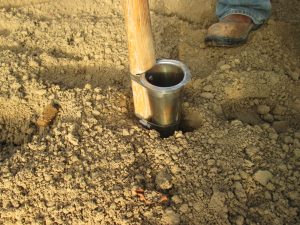We can never emphasize too much the importance of conducting soil tests. Ideally, soil test should be conducted on a yearly basis. The reason soil testing is so important is because it provides information about the nutrient composition of the soil so that growers will know how much fertilizer to apply for the following season. In addition, soil tests enables farmers to find out if there are concerns, such as pH, salinity etc. If these factors are off track, we might be able to address the problems before planting. In most cases, addressing the problems before planting is more efficient and cost effective than during the season.
Purdue Agronomy Extension provides a list of laboratories that offer soil test services https://ag.purdue.edu/agry/extension/pages/soil_testing.aspx I will use the A&L Great Lakes Lab as an example, explaining how to use this service. A&L Great Lakes laboratories provide seven (S1 to S7) soil test packages. S1 is the basic test covering organic matter, pH, cation exchange capacity and macronutrients including phosphorus, potassium, magnesium, calcium. I would recommend you invest a little more money for their recommendations. In that way, you will receive the information regarding the amount of lime, and P, K, Mg, Ca fertilizers you should apply according to the next crop and the soil status. If you want to have a better understanding of each of the characters, Interpretive Guide for soil Test Reports (https://cdn.shopify.com/s/files/1/0979/5626/files/FS21_-_Interpretive_Guide_for_Soil_Test_Reports.pdf?14031145444614994333 ) is a good source for the information.
You may notice that the basic package does not include nitrogen. This is because nitrogen is readily leachable in soil, it changes dramatically during the season, and what shows in the soil test does not reflect what is in soil at the time when plants need it. Because of these reasons, nitrogen is normally not included in the soil test. Then how do we determine the amount of nitrogen fertilizers we should apply? A great source to find the information is through Midwest Vegetable Production Guide for Commercial Growers 2017 (https://ag.purdue.edu/btny/midwest-vegetable-guide/Pages/default.aspx ). The handbook provides the information of nitrogen requirements for most vegetables. When you are searching for the information in the handbook, you may notice the recommendations vary according to soil organic matter. This is because soil organic matter serves as a slow released fertilizer source in the soil. A portion of the nitrogen can be supplied through organic matter decomposition. Therefore, fewer nitrogen fertilizers are needed with high organic matter soils. With that said, we should understand now that although basic soil test does not include nitrogen, the soil organic matter information would provide us a clue of determining how many nitrogen fertilizers should apply.
Soils provide enough micronutrients in most cases. But because vegetable crops can be particularly sensitive to certain micronutrients. It is recommended to include micronutrients in the soil test. A&L Great Lakes laboratories provide service S3 covering the most important micronutrients (zinc, manganese, iron, copper and boron) and sulfur. The lab also provides recommendations for the amount of micronutrients needed if they are in the low range.
Another service I would recommend vegetable growers particularly those growing vegetables in high tunnels to consider is S2 (basic test plus soluble salts and sodium). Because high tunnel excludes natural rainfall and snow, the extra fertilizers we applied over the years can accumulate in the soil to a high salt level. High tunnel growers should always watch for the soluble salts level in their soil and be cautious about applying fertilizers. Soil test is a great way to find out if salinity is a concern.
Last but not least, if you are uncertain how to take soil samples, this publication is a great source for the information https://cdn.shopify.com/s/files/1/0979/5626/files/Soil_Sampling_Analysis.pdf?9125530855932982961 Remember that the lab will send you the results no matter what soil you send to them, but only if you did right in sampling soil, the results won’t be meaningful or even could be misleading for the decisions you need to make.
